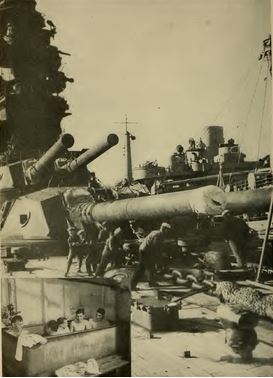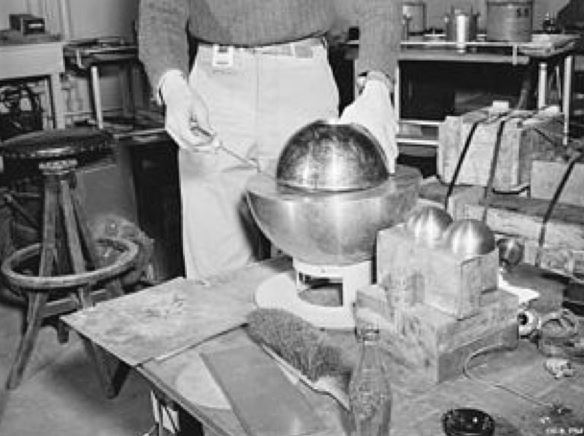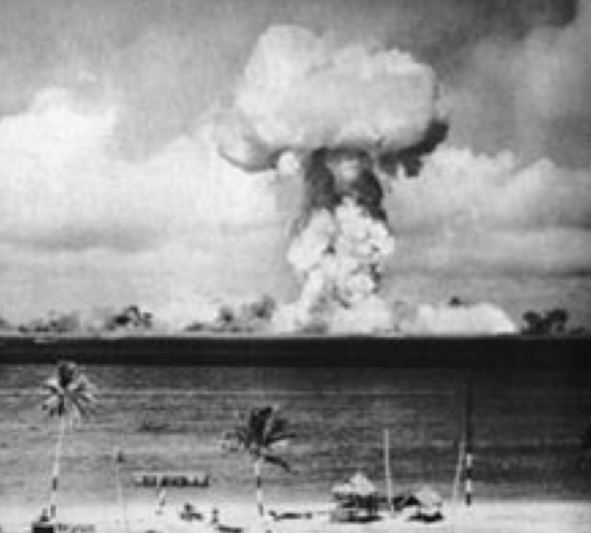Demon Core

(Deck Department puts turns on Nagato’s anchor chains after Test Able).
Between swimming in the lagoon and supervising the Bo’sun as he began to order the deck department to commence dogging hatches and assisting the technicians place their sensors there was enough to do, though the morning rains and the sultry afternoons made any time below decks or inside the armored citadel of the ship oppressive. The things we did not know about the Atomic Age were legion, and we would soon be finding out some more.
Idle hands are the devil’s workshop, and people got to talking about things that strictly speaking we didn’t have a need to know. One afternoon I struck up a conversation in my office in Ship’s Admin. He was aboard to place some special motion sensors with needles that would record the impact of the Test BAKER base surge on Nagato’s hull.
It turned out he was a mid-grade member of the engineering team from Los Alamos where the bombs were assembled after the fissile material arrived form the Hanford Nuclear Reservation in Oregon. I offered him some Navy coffee that we made with water distilled from the water in the atoll and he accepted gratefully. He put his feet up on my metal desk and slumped into the Navy-issue straight backed chair. He then proceeded to tell me an amazing story. Apparently the A-Bomb we called “GILDA” was powered by something called The Demon Pit, which was so lethal that it had already killed two physicists working on the Manhattan District Engineering Project.
He told me there was very little of the “plutonium” material needed to make the core of the bombs. Gilda was only the fourth one ever manufactured, and only the second of the “Fat Man” design, one of which was used against Nagasaki.
The experiments that were conducted at Los Alamos were designed to guarantee that the “core” was indeed close to the critical point by arranging reflectors around them and seeing how much (or how little) neutron reflection was required to approach super-criticality- the place where things go “boom,” like GILDA had done just a few days before. It was a marvel that something that small- six or seven pounds- could produce an explosion equal to that of tens of thousands of tons of TNT.
“On August 21, 1945, the plutonium core that would become GILDA produced a burst of radiation that killed a physicist named Harry Daghlian. Apparently he was working alone in the lab with the core, performing experiments on the reflector arrays that would surround it. Harry was placing a stack of neutron-reflective tungsten carbide bricks around the core. Each time he moved one of them he was also moving a step closer to making the core go critical. While attempting to stack an additional brick around the assembly, Harry accidentally dropped it onto the core, causing it to go well into super-criticality, which is a self-sustaining critical chain reaction. He lunged forward and grabbed the brick off the assembly but it was too late. In less than a second Harry had received a fatal dose of radiation. He died 25 days later from acute radiation poisoning.”

(A recreation of the experiment during which the 1946 accident occurred. The half-sphere is seen but the core inside is not. The beryllium hemisphere is held up with a screwdriver).
Gilda would soon kill again. On May 21, 1946, a physicist named Louis Slotin and seven other Los Alamos personnel were in a laboratory conducting another experiment to verify the exact point at which the core of fissile material could be made critical by positioning neutron reflectors around it.
“Slotin was demonstrating the technique to another physicist, since he was going to use it in the ABLE Test here at Bikini.”
Despite the heat and humidity, I felt the hairs stand up on my arms as I listened to the scientist describe the scene. This is about the most expensive and secret program in the history of mankind, after all and it all seemed a bit casual. The Scientist continued: “See, the trick is that you place two half-spheres of beryllium around the core to block the neutrons. You then lower the top reflector over the core by a thumb hole on the top, sort of like a bowling ball.”
“The bowling ball from hell,” I said.
“Exactly. Allowing the two reflectors to close completely could result in the instantaneous formation of a critical mass and a lethal release of radiation, The way Louie would do it, he would take the blade of a screwdriver and keep it between the edges of the two hemispheres. He was pretty cocky about it and was the local expert we turned to when we tried to calibrate the things. The only thing preventing the core from going super-critical was the blade of a standard straight screwdriver and Slotin’s ability to keep it twisted just enough. He must have done it a dozen times, wearing just his signature bluej eans and cowboy boots. He did it once in front of the greatest Atomic cientist in the world, Enrico Fermi, who was not impressed.”
“What did he say?” I asked, wishing there was a cold Coca Cola on the ship, or maybe just a tot of the grain alcohol the pirate crew had found and never shared with the officers.
“Fermi said Slotin would be dead within the year. And he was right. On the day of the accident, Slotin’s screwdriver slipped outward a fraction of an inch while he was lowering the top reflector, which allowed the reflector to fall into place around the core. There was an intense flash of blue light and a wave of heat across Slotin’s skin as the core released an intense burst of neutron radiation. It was over in less than a second, but the damage was done. His body shielded the others in the lab at the time, but he received a lethal dose of gamma rays in under a second and died nine days later. The guy he was teaching was partially and also got a severe dose but eventually recovered.
“This is amazing information. This plutonium stuff sounds kind of frightening.”
“It did to the people at Los Alamos as well. After that, the plutonium intended for the Fat Man bombs were referred to as the “demon cores”.[Hands-on experiments were forbidden and remote-control machines were designed by one of the survivors, to perform the experiments. All personnel were directed to remain a quarter-mile away from the laboratory.”
“You bet. I don’t think we really understand what we are dealing with here, but we needed to get it ready and use it to stop the war. Otherwise, a lot more people would have died.”
“I imagine so. Do you really think the people on Joint Task Force ONE understand all the ins and outs of this radiation business?”
“Of course. We have the best scientists in the world on this.”
“That is a relief. Two more tests to go here at Bikini and we can all go home.”
“Amen to that. But I suspect there is going to be a lot more of this in the days ahead.”

(GILDA, the 23-kiloton air-deployed nuclear weapon using the “demon core”, detonated on July 1, 1946 during Test ABLE. Photo USN).
Copyright 2015 Vic Socotra
www.vicsocotra.com
Twitter: @jayare303
